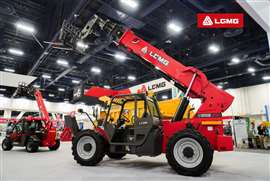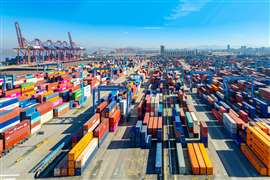What are MEWP manufacturers saying about US tariffs?
14 February 2025
US President Donald Trump is threatened to impose a 25% tariff on imports from Canada and Mexico. International Rental News reports on how aerial platform manufacturers have responded.
It has to be said that aerial platform OEMs were not rushing to provide comment on the tariff issue in the US, in part because the situation is so fluid - will the 25% tariffs on mexico and Canada be applied? - and probably also because it risks getting drawn into direct comment on US government policy, which can be sensitive territory.
The issue will impact OEMs who have established manufacturing facilities in Mexico - which includes Terex, JLG, LGMG, Sinoboom and Skyjack - as well as Skyjack itself in its home territory of Canada. And, of course, it will determine the manufacturing strategies of OEMs into the future.
Speaking for JLG Industries, Brent Miller, vice president of Sales Administration, Marketing, and Latin America, tells IRN that US tariffs help protect US markets from unfair trade practices created by producers selling goods below market value or receiving unfair subsidies.”
“We welcome regulatory actions and legal enforcement to protect industries and workers,” he says.
Miller says US and European manufacturers of booms, scissors and telehandlers have faced unfair competition from “unreasonably low-priced products produced by Chinese manufacturers as they sell in the North American and EU markets.
 LGMG’s H1056 telehandler, designed for the North American market.
LGMG’s H1056 telehandler, designed for the North American market.
“We support free and fair global competition within the access equipment market for the benefit of all stakeholders, including customers, partners, team members and communities.”
JLG began producing scissor lifts at a facility in León, Mexico, about 10 years ago, meeting the demand across North America and other international markets.
The company still produces most of its products in its factories in Pennsylvania and Tennessee for US customers.
In 2022, it opened a 1,000 sqm warehouses in Silao, Mexico. The facility stores units from JLG’s global manufacturing plants for delivery across Mexico within 24 hours. It also serves as a hub for customer visits, product showcases and training events.
Miller outlines how Mexico could remain a manufacturing hub even in the event of big US tariffs; “As a strategic manufacturing powerhouse, Mexico benefits from nearshoring to the US, and its market now rivals Brazil’s, boosting optimism at JLG,” he says.
“Mexico’s construction market is booming, positioning the country as a key hub for global manufacturers.”
He says JLG is strengthening its market position in the country by consolidating product flow from global facilities to its warehouse in Silao and improving delivery times across Latin America.
Construction activity in Latin America remains strong, says Miller, while stable commodity prices and rising petroleum prices favour the access equipment industry. He says that, with access equipment still in the early stages of adoption in the region, significant growth potential exists that could last for decades.
Speaking to financial analysts in January, John Pfeifer, the CEO of Oshkosh Corp, JLG’s parent, pointed out that most of Oshkosh’s goods sold in the US are made in the country. He said the company had flexibility in how it managed its manufacturing, and used the example of Europe, where tariffs imposed by the EU on Chinese imports of MEWPs had led JLG to switch supply from its factory in China to existing European facilities.
He added; “If there’s tariffs that affect us in terms of our supply chain or our products that we might be bringing in from an operation outside the US, we will make similar adjustments to mitigate the impact of the tariff and do what the US is telling us to do, manufacture more in the US, but the vast majority of what we do in the US is made in the US.”
Linamar response to tariffs
Meanwhile, Linamar, owners of Skyjack in Canada, posted a note to shareholders in early February. Its main concern will be its automotive parts business, but also its Industrial division, which is largely made up of Skyjack.
Linda Hasenfratz, executive chair, and Jim Jarrell, CEO and president, said its competitors building machines in the US “only have so much capacity to fill customer orders, meaning a need for our industrial businesses to still supply product.
“We have taken some early action in this regard to prioritise US-bound orders and to also have placed a buffer of inventory of our industrial products already in warehouses in the US. This will allow us to continue to ship tariff free to our customers until that inventory runs out.
“It is our hope that this strategy will buy us some time until the tariffs are lifted from Canadian and Mexican imports into the US.”
Hasenfratz and Jarrell said there was absolutely no plan to shift production to the US and that the business did not make decisions based on short term issues such as tariffs.
They added; “Lastly, remember tariffs don’t create prosperity they destroy it. No imposition of a tariff regime in history has resulted in prosperity, only inflation, a decline in productivity and economic depression.
“In the end we all want the same outcomes, a healthy economy with good job opportunities for all of our countries and a good way of life for all our people.”
“A bit of a roller coaster”
For Terex Corp, owner of the Genie business, the first few weeks of the new US administration had been “a bit of a roller coaster”, said president and CEO Simon Meester.
He told analysts at the Q4 results announcement at the beginning of February that the majority of the products it was selling in the US were made in the US, “which limits our exposure. Moreover, we initiated mitigation actions last year in anticipation of additional tariffs, leveraging our global capabilities to manage the impact.”
Meester pointed out that Terex has 11 factories in the US, one in Mexico and one in Canada; “we have a lot of optionality...no matter what the outcome will be. We run single shifts in most of our US factories. We can re-route demand across our factories. We source from the Monterrey facility [and] from other facilities as well. So we have a dual source setup that we can play with.”
He said the company’s Monterrey facility in Mexico was “world class...state of the art manufacturing and we can use that facility no matter what happens with the US landscape. But we like where we are from a competitive standpoint.”
He added that the business had “multiple mitigation plans ready to go if the situation would change. And we think that if something were to happen, we would be able to mitigate most of it and it wouldn’t make a significant impact on our guidance either way.”
What about the Chinese OEMs?
Chinese manufacturers including Sinoboom and LGMG have invested in Mexican production plants.
A spokesperson for Sinoboom says the company will provide updates about its new Siao facility in Mexico later this year when it has more information to share. The company held the groundbreaking ceremony in August last year for the facility that will produce slab and rough-terrain scissor lifts, articulating and telescopic boom lifts, telehandlers and vertical mast lifts.
Dingli, which owns US manufacturer MEC Aerial Platforms, said it preferred not want to comment on the issue of tariffs.
Meanwhile, LGMG opened a factory in Monterrey, Mexico, in late 2023. The factory now has 500 employees and produces rough-terrain electric scissors, boom lifts up to 80 feet, and—most recently—a 10,000lb (4.5t), 56ft (17m) capacity, diesel-powered H1056 telehandler for North America.
Ares Song, the head of the export department at LGMG’s aerial platform international marketing division, speaking to IRN at Bauma China last November, said potential US tariffs would prompt LGMG to review how it uses its Mexican and Chinese production plants.
“The cost of manufacturing in Monterrey is higher than China. We are looking at which products are most competitive from China or Monterrey…We can use both factories to supply to Europe,” Song says.
“We are still waiting for the countervailing [decision from the EU], and then we will do further cost calculations. But we will be ready to use two factories to supply Europe.”
On January 17, the European Commission updated its agreement with Mexico to further boost bilateral trade between the two. Under the existing EU-Mexico Global Agreement, there are generally no tariffs on machinery exported from Mexico to the EU.
Commenting on Trump’s potential tariffs on imports from Mexico, a spokesperson for LGMG tells IRN that the company remains optimistic about the challenging market and the complicated international situation, adding, “As the saying goes, all roads lead to Rome.” In other words, there are many ways to achieve the same result.
Whatever the final tariff arrangements, OEMs will be hoping that they can manage the landscape without the need to pass on added costs and increase prices. That’s certainly what their customers will be hoping.
STAY CONNECTED



Receive the information you need when you need it through our world-leading magazines, newsletters and daily briefings.
CONNECT WITH THE TEAM









